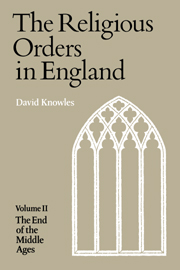Book contents
- Frontmatter
- Contents
- Preface
- List of Abbreviations
- Part One The Historical Framework
- Part Two The Institutional Background
- Chap. XVII Recruitment, employment and the horarium
- Chap. XVIII The wage-system and the common life
- Chap. XIX The election and privileges of the superior
- Chap. XX The numbers of the religious
- Chap. XXI Literary work
- Chap. XXII The monasteries and society
- Chap. XXIII Vicarages, the cure of souls and schools
- Chap. XXIV Public obligations of heads of houses
- Chap. XXV The monastic economy, 1320–1480
- Chap. XXVI Monastic Libraries
- Chap. XXVII Retrospect
- Appendix I Chaucer's monk
- Appendix II Henry V and the Westminster recluse
- Appendix III Regulars as bishops
- Bibliography
- Index
Chap. XX - The numbers of the religious
Published online by Cambridge University Press: 28 January 2010
- Frontmatter
- Contents
- Preface
- List of Abbreviations
- Part One The Historical Framework
- Part Two The Institutional Background
- Chap. XVII Recruitment, employment and the horarium
- Chap. XVIII The wage-system and the common life
- Chap. XIX The election and privileges of the superior
- Chap. XX The numbers of the religious
- Chap. XXI Literary work
- Chap. XXII The monasteries and society
- Chap. XXIII Vicarages, the cure of souls and schools
- Chap. XXIV Public obligations of heads of houses
- Chap. XXV The monastic economy, 1320–1480
- Chap. XXVI Monastic Libraries
- Chap. XXVII Retrospect
- Appendix I Chaucer's monk
- Appendix II Henry V and the Westminster recluse
- Appendix III Regulars as bishops
- Bibliography
- Index
Summary
The strength of the monastic population of England has in the past been the subject of much speculation, and it had often been assumed till recently that nothing but speculation was possible. In fact, however, the material for fairly accurate statistics has for long been accumulating in print, and only the patient work of a careful scholar was wanting. Direct statements of numbers in chronicles or narratives are indeed very scanty, especially after the twelfth century, but in later times precise figures can often be found in the record sources. Thus the acts of an election or a visitation often give, either explicitly or by implication, the numbers of a community, while in the case of a few great monasteries—Christ Church, Canterbury, Westminster and Durham are perhaps the only examples—we possess what amounts to a complete list of the monks for two or more centuries. Elsewhere, and especially in the case of the mendicants, the numbers can often be deduced with some accuracy from the sums given by benefactors for a supply of clothing or one or more days' provisions. Yet another source is the records of the poll taxes of 1377, 1379 and 1380–1, while for the last years there are abundant and detailed materials. These last, however, have their own difficulties of interpretation, and will be more fully considered on a later occasion. Such was some of the material available, and in recent years two scholars, working independently and unknown to each other, have examined these and other sources and applied to the figures elicited the technique of the demographical statistician.
- Type
- Chapter
- Information
- Religious Orders Vol 2 , pp. 255 - 262Publisher: Cambridge University PressPrint publication year: 1979



